Views of Tenant Farmers and Agricultural Landlords on Aspects of the Agricultural Tenancy System
Results from surveys of tenant farmers and agricultural landlords on aspects of the tenancy system such as rent review, fixed equipment, diversification and tenancy relationships.
3 TENANTS FARMERS AND LANDLORDS
Summary
1. Similar to earlier surveys of both audiences, both tenant farmers and landlords were generally positive towards each other, and towards specific aspects of this relationship. Tenant farmers were also positive about their relationship with their landlord's representatives, in cases where such a person exists.
2. Both tenants and landlords were most likely to say that tenancy issues are discussed face-to-face more than once per year.
3. While there was broad agreement between both audiences in terms of when the most recent rent review had been carried out on the tenancy, different pictures emerged in terms of the frequency with which rent reviews occurred.
4. The median annual rent per acre paid by tenant farmers was £43, while the median rent per acre received by landlords was £38.
3.1 This section looks at some of the detail of the tenant-landlord relationship, identifying the nature of agricultural landlords and who is employed to act on landlords' behalf to carry out various duties relating to the main tenancy. It also discusses issues relating to rent reviews and changes in rent paid and received.
3.2 One-third (34%) of tenant farmers reported that the landlord on their largest lease was a trust or charity, with 28% saying that it was an individual, 18% a family business, and 12% a limited company (Figure 3.1).
3.3 In contrast, 33% of landlords reported that rented-out land was owned by an individual, 24% by a trust or charity, 18% by a partnership within the EU, and 10% by a family business[14].
3.4 Reasons for the difference in reported profile of land ownership between tenant farmers and landlords may include:
- Larger landlords, such as public sector organisations, are likely to have multiple tenants.
- Tenants may not know the business structure adopted by their landlord, for example the difference between a partnership, a family business, trust may not be totally transparent
- 'Partnership' was not a response option in the survey of tenant farmers.
Figure 3.1: Reported profiles of landowners of tenanted land
Tenant farmers Q. Which of these best describes the landlord for this lease?
Landlords Q. Which of these best describes who owns the land?
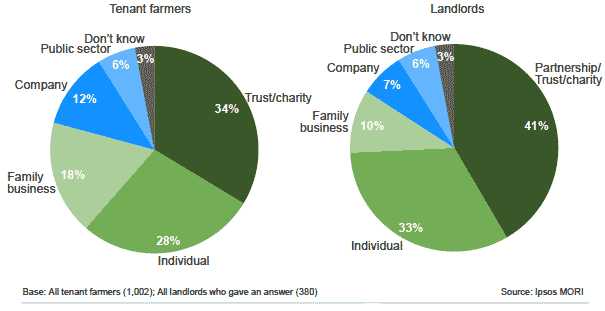
3.5 Half of tenant farmers reported that their landlord lives on or near the land they lease (48%), while a similar proportion (50%) said that their landlord does not live on or near the land. Tenant farmers were more likely to say that their landlord lived on or near the land if their landlord was an individual or family business (59%) than if the landlord was a charity or trust (48%), a company (30%), or a public sector organisation (8%).
3.6 In contrast, the majority of landlords with leases of more than one year and who answered the question (78%) reported that they live on or near the land covered by their largest lease. The remaining 22% said that they do not live on or near the land.
3.7 When asked to describe their relationship with their landlord, 82% of tenant farmers said that the relationship was good (44% said it was very good). On the other hand, 13% described the relationship as poor (Figure 3.2).
3.8 Those whose main lease is an LDT/SLDT or other type of arrangement were more likely than those with a Secure 1991 Act tenancy to describe the relationship as very good (53% and 50% compared to 38%). Tenant farmers whose main lease is a Secure 1991 Act tenancy (10%) were more likely than those with an LDT/SLDT (8%) or other types of tenancy arrangements (11%) to describe this relationship as poor.
Figure 3.2: Tenant-landlord relationship
Tenant famers Q. How would you describe your relationship with your landlord?
Landlords Q. How would you describe your relationship with the tenant who holds this lease?
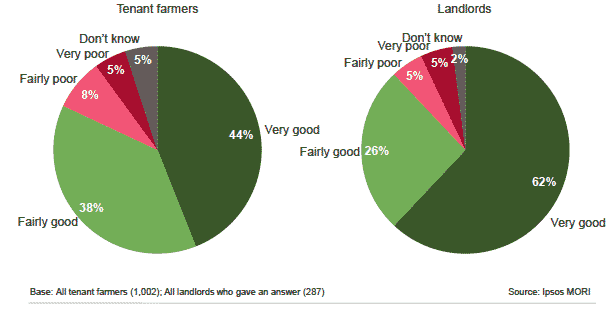
3.9 Landlords' perceptions of their relationship with their tenant were comparable with those of tenant farmers. Of those who answered, 89% of landlords described their relationship with their main tenant as good (62% very good), while only 10% described it as poor.
3.10 When asked who they normally deal with on tenancy matters other than rent reviews, tenant farmers reported that they usually dealt with a resident factor (38%), the landlord (31%), or the landlord's normal agent (25%) (Figure 3.3). Those whose landlord was a charity or trust (46%) or a company (43%) were more likely to normally deal with a resident factor than tenants whose landlord is an individual or family business (31%).
Figure 3.3: Who deals with tenancy matters
Tenant farmers Q. Excluding rent reviews, who do you normally deal with on tenancy matters?
Landlords Q. Excluding rent reviews, who normally communicates with this tenant farmer on matters relating to the lease?
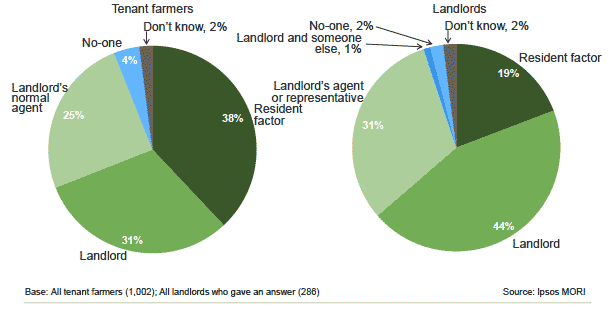
3.11 Among landlords with leases of more than one year, in 44% of cases the landlord or representative of the business which owns the land would communicate with tenant farmers on matters relating to the lease, other than rent reviews. In 31% of cases this was done by an agent or representative of the landlord, while a resident factor did so 19% of the time.
3.12 Tenant farmers who normally deal with the landlord's agent or a resident factor, were asked to rate the relationship that they have with this person. Three-quarters (76%) of respondents described this relationship as good (32% very good), while 19% described it as poor (Figure 3.4). Those whose main lease is a Secure 1991 Act tenancy (22%) were more likely to describe this relationship as poor, than those whose main lease is an LDT/SLDT (12%).
Figure 3.4: Tenant farmers' views on relationship with landlord's representative
Q. How would you describe your relationship with your resident factor/landlord's normal agent?
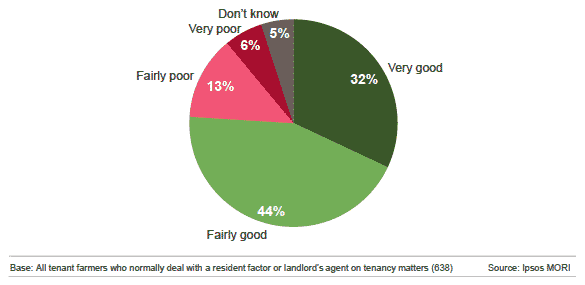
3.13 Tenant farmers who deal with someone on tenancy matters were asked how often, if at all, they met face-to-face to discuss tenancy matters (excluding rent reviews). A similar proportion said that they met more than once a year (26%), about once a year (23%), and less than once every two to three years (24%). Seventeen per cent said they met face-to-face about once every two to three years (Figure 3.5).
Figure 3.5: Tenant farmers views on frequency of contact with landlord on tenancy issues
3.14 When asked how often they get written correspondence about their tenancy, one-third (34%) of tenant farmers said that this occurs less often than once every two to three years. Fewer respondents said that they receive written correspondence once every two to three years (14%), more than once a year (17%), about once a year (18%); while 16% said that they only receive written correspondence for rent reviews.
3.15 Less than two-thirds of landlords who rent-out on leases of more than one year reported that they or their representative met face-to-face with tenants to discuss their tenancy more than once a year (62%), with 19% saying that this happens about once a year (Figure 3.6). Those who are satisfied with their relationship with their tenant (68%) were more likely than those dissatisfied with this relationship (39%) to meet face-to-face with the tenant more than once a year.
Figure 3.6: Views of landlords on frequency of written contact on tenancy issues
Q. Excluding rent reviews, how often, in at all, do you meet face-to-face to discuss tenancy issues?
Q. Excluding rent reviews, how often do you get written correspondence about your tenancy?
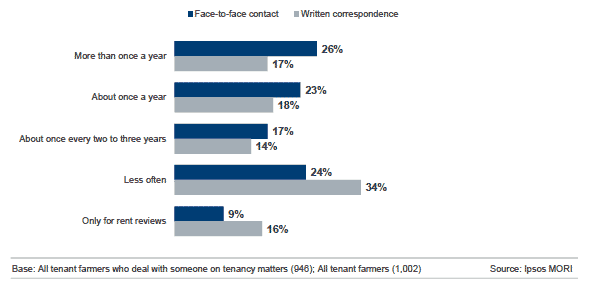
3.16 Thirty per cent of those landlords who answered said that written communication with tenants on issues related to the lease happens more than once a year; with 20% saying that this happens around once a year, 13% once every two to three years, 17% less often, and 10% only had written correspondence for rent reviews.
Attitudes towards tenancies
3.17 When asked to rate their satisfaction with their current tenancy, just over three-quarters (77%) of tenant farmers reported that they were satisfied (33% very satisfied), with only 11% saying that they were dissatisfied, and a further 11% who were neither satisfied nor dissatisfied (Figure 3.7). Satisfaction among landlords was comparable, with 78% of landlords satisfied with their tenant (48% very satisfied), with 13% dissatisfied and a further 9% neither satisfied nor dissatisfied.
Figure 3.7: Satisfaction with tenancy
Tenant farmers Q. Overall, how satisfies or dissatisfied would you say you are with your current tenancy of this lease?
Landlords Q. Overall, how satisfied or dissatisfied would you say you are with this tenant?
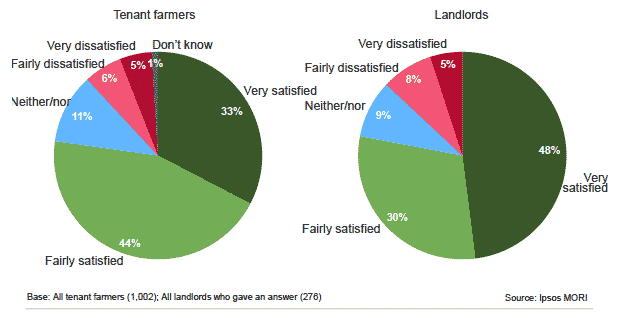
3.18 Tenant farmers and landlords were presented with a series of attitudinal statements concerning the tenant-landlord relationship, and issues around the lease. Half of the statements concerned general perceptions of the lease, while the other half were about issues around the tenant-landlord relationship. Overall, both groups of respondents were generally positive towards the tenant-landlord relationship and in terms of lease issues.
3.19 For the statements which centred on lease issues, tenant farmers tended to have a positive view (Figure 3.8):
- 86% agreed (21% strongly) with the statement 'The rent I pay is reasonable), while 13% disagreed
- 79% agreed (23% strongly) with 'I have a good working relationship with my landlord; 17% disagreed
- 69% agreed (15% strongly) with the statement 'It provides a good home and lifestyle for my family', and 21% disagreed.
3.20 However, tenant farmers were more negative towards the statement 'My landlord encourages me to diversify': 61% disagreed with the statement, while a quarter (25%) agreed.
Figure 3.8: Tenant farmers' attitudes towards the lease
Q. Thinking about this lease, to what extent do you agree or disagree with the following statements?
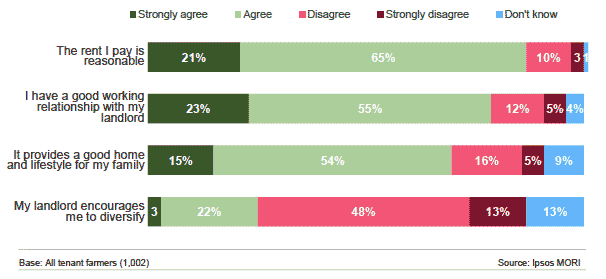
3.21 In terms of the other statements concerning aspects of their relationship with their landlord, tenant farmers were generally positive, although opinion became progressively more divided (Figure 3.9):
- 84% disagreed (35% strongly disagreed) that 'The landlord is rude or unhelpful', while 12% agreed
- 75% disagreed with the statement 'The landlord restricts my business operations', while 22% agreed
- 68% disagreed that 'The landlord is disinterested', while a quarter (26%) agreed
- 59% disagreed with 'The landlord takes too long to deal with problems', while 35% agreed with this statement.
Figure 3.9: Tenant farmers' attitudes towards the tenant-landlord relationship
Q. Thinking about this lease, to what extent do you agree or disagree with the following statements?
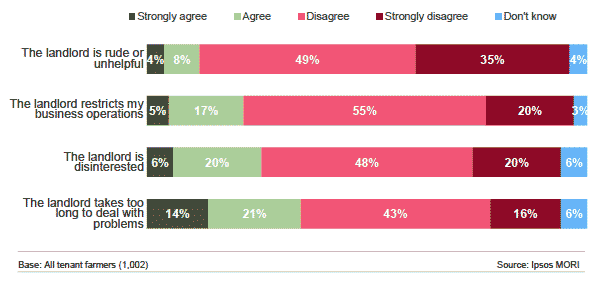
3.22 There appears to be a relationship between respondents' perception of their relationship with their landlord and being encouraged to diversify. Those with a good relationship with their landlord were more likely to agree that they are encouraged to diversify (29%) than those with a poor relationship (6%); while those with a poor relationship (90%) were more likely to disagree with the statement than those with a good relationship with their landlord (56%).
3.23 Landlords' attitudes were also generally positive towards aspects of the relationship with their tenant. Again, opinion was divided on some issues more than others (Figure 3.10):
- 87% agreed (42% strongly) that 'I have a good working relationship with my tenant'; 10% disagreed
- 74% agreed (23% strongly) that the lease 'provides a good home and lifestyle for my tenant', while 11% disagreed
- 58% disagreed that 'I feel pressured to low/no rent increases'; 37% agreed
- 52% agreed with the statement 'I encourage my tenants to diversify', while 29% disagreed (which contrasts with tenant farmers' view of this issue).
Figure 3.10: Landlords' attitudes towards the lease
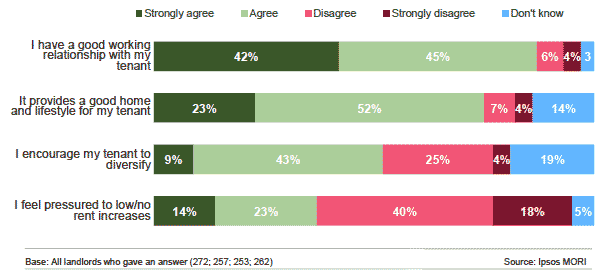
3.24 Landlords were also generally positive towards those statements which concerned aspects of the tenant-landlord relationship, although opinion again becomes more divided (Figure 3.11):
- 91% disagreed (47% strongly) with the statement 'I restrict the business operations of my tenant', while 5% agreed
- 85% disagreed (52% strongly) with 'The tenant is rude or unhelpful', while 10% agreed
- 78% disagreed (39% strongly) that 'The tenant is not interested in what I think'; 16% agreed
- 74% disagreed (25% strongly) that 'The tenant takes too long to deal with problems', and 18% agreed.
Figure 3.11: Landlord's attitudes towards the lease
Q. To what extent do you agree or disagree with the following statements about this lease?
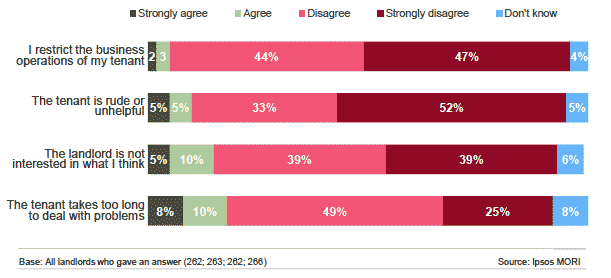
Rent reviews
3.25 Overall, both tenant farmers and landlords reported broadly similar experiences of rent reviews in terms of their frequency, the timing of the most recent review, and in terms of who carried out the review itself.
3.26 One-third (32%) of tenant farmers reported that the rent is reviewed on their main lease every two to three years, while 13% said that it is reviewed every four to five years, and a similar proportion said that the review occurs every six to ten years (13%). One in five (18%) said that their rent has never been reviewed (Figure 3.12).
Figure 3.12: Frequency of rent review on main lease
Q. Generally, how often has the rent been reviewed on your/this lease?
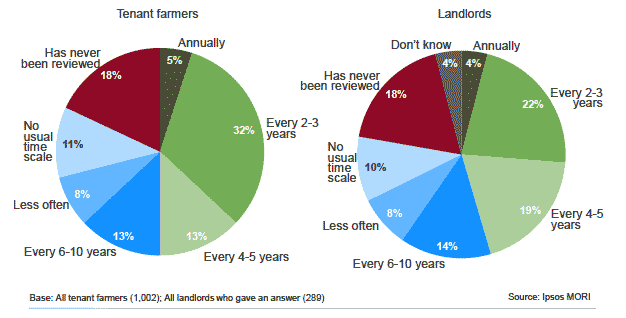
3.27 While the general pattern reported by landlords is broadly similar to that reported by tenant farmers, there were some differences. Twenty-two per cent of landlords reported that the rent is reviewed on their main lease every two to three years (compared with 32% of tenant farmers); while 19% said that this happens every four to five years (compared with 13%).
3.28 Thirty-eight per cent of tenant farmers reported that the last rent review on their lease was completed in or before 2010. One in five said that it was completed in 2013 (20%) or in 2012 (19%) (Figure 3.13).
3.29 Again, while the broad pattern of response among landlords was similar to that of tenant farmers, there were differences over specific details. Thirty-five per cent of landlords said that the last rent review was completed in or before 2010, while 17% said that it was reviewed in 2013, and 24% that the most recent review was in 2012.
Figure 3.13: Most recent rent review on the lease
Q. When was the last rent review on this lease completed?
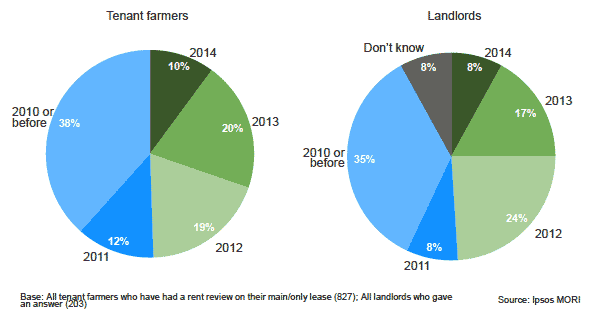
3.30 Tenant farmers were most likely to say that the rent review was carried out by the resident factor (38%), with the landlord's normal agent (23%), and the landlord (22%) also frequently mentioned. It was less common for tenants to say that the rent review was conducted by a land agent appointed specifically to undertake the task (11%) (Figure 3.14).
3.31 In contrast, one-third (32%) of landlords said that the rent review was carried out by their normal agent, while one in five said that it was done by a resident factor (20%). A comparable proportion of landlords to tenant farmers (22%) said that the review was carried out by the landlord directly. Fifteen per cent said that the review was carried out by a land agent specifically appointed for this task.
Figure 3.14: Who normally carries out the rent review
Q. Who normally carries out the rent review?
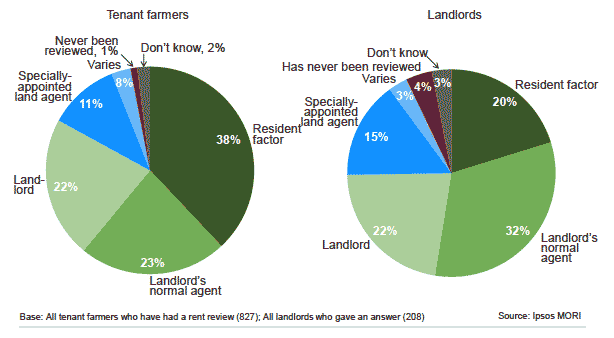
3.32 Tenant farmers who reported that their rent review is carried out by a specially-appointed land agent were asked to rate their relationship with the agent. More than half (52%) felt that the relationship was good, while around one-third (32%) described it as poor (Figure 3.15).
Figure 3.15: Relationship with specially-appointed land agent
Q. How would you describe your relationship with the person who normally carries out the rent review?
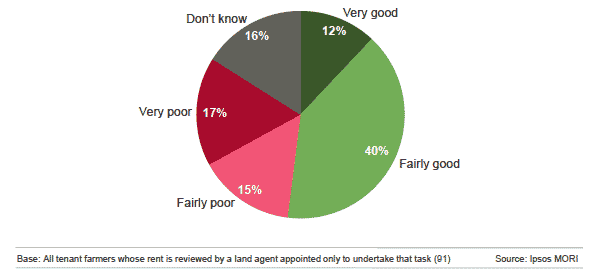
3.33 All tenant farmers who reported having had a rent review on their lease were asked by what percentage their rent changed at their last rent review. Sixteen per cent reported a rent increase of between 1% and 5%, 22% said that their rent had increased by 6% to 10%, 9% reported an increase of 11% to 15%, with 17% having had an increase of between 16% and 25%. A further 12% of tenant farmers reported an increase of between 25% and 100%, with 2% saying their rent had increased by more than 100%. One in five (12%) reported not having had an increase (Table 3.1). The mean change in rent was an increase of 19%, although given the variation in frequency of rent reviews reported in 3.25-3.27 above, this does not represent an annual increase.
3.34 In contrast, no landlords reported a rent increase of 1% to 5%, while one in five landlords said that the rent increased by between 6% and 10% (19%), 11% to 15% (18%), or 16% to 25% (18%) at the last rent review. One in ten (11%) reported that it had increased by between 26% and 50%. A further one in ten (9%) said that there had been no increase. The mean change was an increase of 18%, which again is not an annual increase.
Table 3.1: Reported percentage change in rent on main lease at last rent review
| % change in rent at last rent review |
Tenant farmers view | Landlords view |
|---|---|---|
| % | % | |
| Decrease in rent | 1 | 0 |
| 0% | 12 | 9 |
| 1% to 5% | 16 | 0 |
| 6% to 10% | 22 | 19 |
| 11% to 15% | 9 | 18 |
| 16% to 25% | 17 | 18 |
| 26% to 50% | 8 | 11 |
| 51% to 75% | 1 | 2 |
| 76% to 100% | 4 | 1 |
| More than 100% | 2 | 1 |
| Don't know | 8 | 15 |
| Base | 824 | 198 |
3.35 A quarter of tenant farmers reported that they pay their landlord between £1-£24 per acre per year, with 29% saying that they pay their landlord between £25-£49 per acre per year, and a similar proportion (29%) paying £50-£74 per acre per year. The median rent paid per acre per year was £43 (£106 per hectare).
3.36 One-third of landlords who answered reported that their main tenant pays between £1 and £24 per acre per year (31%) or between £25-£49 per acre per year (31%), with a further 21% saying that they are paid between £50 and £74 per acre per year. Smaller proportions of respondents reported that they are paid between £75-£99 (6%), £100-£499 (5%), £500-£999 (2%), or £1,000 or more per acre per year (2%). The median rent per acre per year was £38 (£94 per hectare).
Contact
Email: Liz Hawkins
There is a problem
Thanks for your feedback